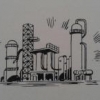Latest Downloads
-
 Water Bath Indirect Heaters
Water Bath Indirect HeatersArt Montemayor - Oct 12 2018 02:35 PM
-
 Petroleum: A Primer for Kansas
Petroleum: A Primer for KansasArt Montemayor - Oct 12 2018 02:27 PM
-
 Spray Tower for Flue Gas Scrubbing Design
Spray Tower for Flue Gas Scrubbing Designankur2061 - May 02 2018 02:31 PM
-
 Selection of Vertical Tanks
Selection of Vertical Tanksankur2061 - Apr 19 2018 07:42 AM
-
 Pressure Drop Calculator for Strainers 1
Pressure Drop Calculator for Strainers 1ankur2061 - Mar 24 2017 02:04 PM
-
 Horizontal Pig Trap System Design Guidelines
Horizontal Pig Trap System Design Guidelinesankur2061 - Jan 14 2017 02:54 PM
-
 Performance Prediction of 3-Stage Propane Refrigeration System
Performance Prediction of 3-Stage Propane Refrigeration Systemankur2061 - Aug 08 2016 02:43 PM
-
 Centrifugal Pump Troubleshooting Checklist
Centrifugal Pump Troubleshooting Checklistankur2061 - Dec 17 2015 08:18 AM
-
 Compressor Troubleshooting Checklist
Compressor Troubleshooting Checklistankur2061 - Sep 08 2015 11:43 AM
-
 Amine Sweetening Unit Preliminary Design
Amine Sweetening Unit Preliminary Designankur2061 - May 19 2015 09:35 AM
Popular Store Titles
 Tank Jacket Calculator
Tank Jacket Calculator
 Specification Sheet Collection
Specification Sheet Collection
 PIPESIZE
PIPESIZE
 Relief Valve Sizing
Relief Valve Sizing
 Rupture Disc Sizing
Rupture Disc Sizing
Chemical and Process Engineering Resources
Submitted Chris Haslego, Nov 21 2011 11:21 AM | Last updated Nov 21 2011 01:29 PM
| Category: | Equipment Design |
| Question: | I would like you to explain to me whether I can apply the packed tower equations (Constant of Henry, L'/ G' ratio, pressure drops,diffusivities, Shulmann correlation, etc) in my design of the cooling tower?. Could you provide the correlation/equation of L/G vs KaV/L without resort to the diagram. How should I apply the value of KaV/L in my design?. |
| Keywords: | designing,cooling,tower,packed,column |
| Answer: | If you are going to design a cooling tower, forget the packed tower correlations, they're very differenttowers. Packed towers rely on increased surface area for mass transfer while cooling towers rely more on air velocity and contact time for mass transfer. Designing a cooling tower in an industrial setting (as described by my article) is different than doing the actual theory of the design. First, you have to answer the following questions:1. What is the highest web bulb temperature for the geography? (for example 75 degrees F)2. How close to the wet bulb temperature do you want to cool the water? Realistically, the best you can hope for is to cool water to 5 deg F above the wet bulb, in our case 80 degrees F. The closer to the wet bulb temp, the larger the tower.3. What is the flowrate and the inlet temp of the water? This will determine how much heat you need to remove.The amount of heat to be removed will determine the tower height (contact time with air while water falls) and air velocity through the tower cell (how quickly heat is removed while the water falls). Typical design L/G ratios range from 0.75 to 1.50. Once the previous questions are answered, the theoretical KaV/L should be calculated via the numerical integration equation shown in "Cooling Towers: Design and Operation Considerations" (see below).Then it is necessary to design the cooling tower fill and air distribution to meet the KaV/L value. Companies that manufacture cooling towers usually have standard towers that they manufacture (as opposed to custom towers). You can see some standards at the second link below.Each one of these towers has a maximum L/G ratio associated with it. I suspect that you're interested in bridging the gap between the L/G ratio and the geometric construction. Since the L/G ratio is always supplied by the cooling tower manufacturer, I don't know how they arrive at it. I suspect it a long history of experience and trial-and-error, but I guess they could have correlations to determine this. |
| Links: | Cooling Towers: Design and Operation Considerations Cooling Tower Standards Cooling Tower Experts |
Forum Quick Links
Tech Q & A Category List
-
 Bulk Solids
Bulk Solids
-
 ChE Outside the Plant
ChE Outside the Plant
-
 Chemical Process Business
Chemical Process Business
-
 Chemistry Basics
Chemistry Basics
-
 Corrosion
Corrosion
-
 Equipment Design
Equipment Design
-
 Experimentation and Testing
Experimentation and Testing
-
 Fluid Dynamics
Fluid Dynamics
-
 Heat Transfer Technology
Heat Transfer Technology
-
 Industrial Utilities
Industrial Utilities
-
 Mass Transfer
Mass Transfer
-
 Physical Property Information
Physical Property Information
-
 Plant Basics
Plant Basics
-
 Plant Economics
Plant Economics
-
 Preparing to Become an Engineer
Preparing to Become an Engineer
-
 Process Control
Process Control
-
 Reactions and Processes
Reactions and Processes
-
 Refining
Refining
-
 Safety
Safety
-
 Separation Technology
Separation Technology
-
 The Environment
The Environment
-
 Thermodynamics
Thermodynamics

 FB
FB



0 Comments